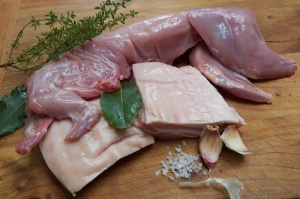I was back in Central Otago last week where every year is the Year of the Rabbit. The farmers here say there are so many rabbits that if you clap your hands loudly you can see the hills move. Believe it. Before I had a chance to put my hands together, I’d already trodden on one. We both got a fright but the farmer just shrugged and told me he’s facing costs of $30,000 to poison them this year – there are far too many to shoot.
Ironically, on this last trip I’d come to Central via Dunedin where a pie man was bemoaning the fact he couldn’t afford to make his Poacher’s Pie because the price of rabbits had gone through the roof. He was paying $16 a shot which gave him just 330g of meat. I’m not sure how much a hunter gets for a rabbit but I’m guessing the added cost must be in the processing.
Whatever the reason, it seems ridiculous that only the best restaurants can afford to serve up a pest that’s hit plague proportions in parts of the country. Having seen the problem at first hand, I figure the best thing you can do to a rabbit is give it a bullet, skin it, cook it and shred it into little pieces. Here’s my recipe for rabbit rilletes.
Rabbit and Pork Rilletes.
I used to make this in France where the rabbits are farmed. They’re plumper and meatier than our wild ones but they come with their heads still attached, which I always found a bit gross because without the fur their eyes are big and gollum like. NZ rabbits are skinnier so I use a higher proportion of fatty pork belly.
1 large rabbit, skinned
400g fatty pork belly
salt, pepper
2 cloves garlic, crushed
2 bay leaves
2 sprigs of thyme or marjoram
Joint the rabbit into 6 pieces and slice the pork belly into thick chunks. Rub salt, pepper, garlic and herbs all over the meat and leave in fridge overnight.
Preheat oven to 150°C. Place meat with seasonings in a heavy duty casserole with half a cup of water then cover with tight-fitting lid. Braise in oven for 2 ½ -3 hours until tender.(Check once or twice and add more water if it’s drying out.)
Remove from oven and leave until cool enough to handle. Pick out the bay leaves and herb twigs and strain off fatty juices. Pull meat off bones and place in large bowl. Using two forks, shred the meat finely, taste for seasoning and pack into a serving bowl. Pat down with a wooden spoon and pour a thin layer of the reserved fat over the top. Chill and serve with toasted bread and pickles.
If you’d rather leave the cooking to someone else, here’s what chef Pascal Bedel can do to a rabbit at Le Canard restaurant in Wellington.









